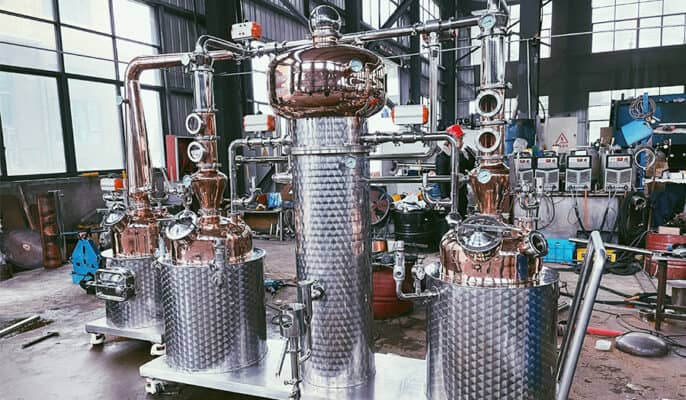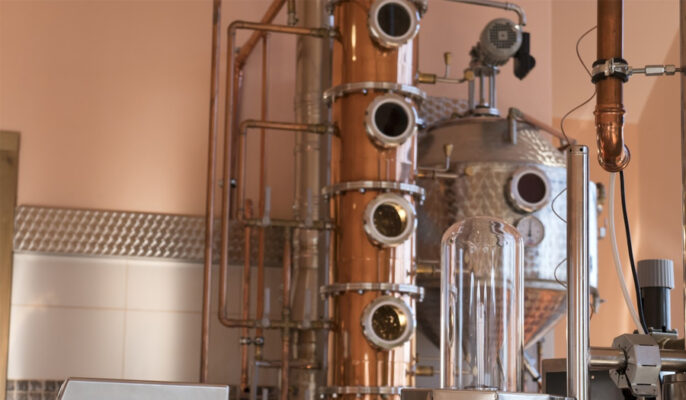Brandy is an aged fruit spirit distilled for a great flavor and has a very long history. Brandy is a distilled spirit made from fruit puree or wine. A wide variety of fruits are used to make brandy, including grapes, apples, and peaches. However, unlike whiskey and bourbon, which are made from a variety of grains, brandy is always made from pure fruit puree. It is loved for its unique flavor and aroma. As a brewing equipment manufacturer, we understand the complexity and technicality of making brandy. In this article, we will take a closer look at the making of brandy and the distillation equipment required.
What are brandy distilled spirits?
Brandy distillate is a fruit-based spirit made through a process of fermentation and distillation. The name “Brandy” comes from the Dutch word “brandewijn”, which reflects the distillation process. Traditionally, brandy is made from grapes, but other fruits such as apples, pears, and cherries can also be used. The choice of ingredients has a major impact on the flavor and quality of the final spirit. The treated fruit (usually pressed into a puree) is mixed with yeast for fermentation.
The yeast converts the sugars in the fruit into alcohol and produces a small amount of carbon dioxide. The fermented liquid (fruit wine) is heated and the alcohol evaporates and condenses into a liquid through a condenser in a process called distillation. The main purpose of distillation is to concentrate the alcohol and extract the flavor components from it. Brandy is usually matured in oak barrels, which adds complexity to its flavor and gives it a distinctive color and texture. The maturation time varies from a few months to a few years, depending on the desired flavor profile.

Different types of brandy
Each type of brandy is unique; the type of fruit used, the method of distillation, and the vintage will determine the flavor profile.
- Cognac: Produced in the Cognac region of France, this brandy is made from white wine distilled into spirits and then aged in oak barrels for at least 2 years.
- Armagnac: Similar to Cognac, but aged longer for deeper flavors and an irresistibly smooth experience, Armagnac is popular around the world.
- Fruit Brandy: This brandy is made from a variety of fruits, such as apples, cherries, or peaches.
- Pisco: Pisco is a South American brandy made from grapes that are usually not aged, resulting in a clear, fresh spirit.
Understanding these types will help you decide which brand you want to make. Whether you want to make a traditional grape brandy or you want to try a different fruit brandy, the choice is yours.
Essential equipment for making brandy
Fermentador
The fermenter is the main piece of equipment that houses the juice and yeast, providing a controlled environment in which the yeast can convert the sugar into alcohol. Fermenters are commonly made of stainless steel, and the tank should have a good seal to prevent external contamination. Select tanks of appropriate capacity according to the scale of production to accommodate the volume of fermentation.
Equipamento de destilação
Distillation equipment is used to distill wine into brandy. There are many types of stills, from simple pot stills to more complex column stills.
- Distillers: The fermenting liquid is heated to evaporate the alcohol and other volatiles, which are condensed into a liquid through a condenser to separate the desired brandy components. It should have a heating system, a condensation system, and a collection device. The design needs to comply with the thermodynamic requirements of distillation to improve efficiency.
- Condenser: cools and condenses the evaporated alcohol vapors into a liquid. Common types of condensers include serpentine condensers and shell and tube condensers. Choosing the right condenser can improve the condensation efficiency.
- Heating System: Heating the distilled liquid provides enough heat to vaporize the alcohol, usually including steam heating, electric heating, or flame heating. Temperature control should be available to accurately regulate the evaporation temperature. The accuracy of the temperature control is critical to the quality of the distillation.
- Fractionating Columns: Fractionating columns usually include multiple fractionating disks or packing to enhance separation. Suitable for high-end distillation equipment. Further separates alcohol and other volatiles to improve alcohol purity and flavor.
- Collection Unit: Collection of distillate separates the different stages of distillate, including the head section, heart section, and tail section. It is equipped with a diversion function to accurately separate different stages of distillation. The heart section is the core part of making brandy. Use corrosion-resistant containers to collect the different parts of the distillate to prevent contamination.
Specific gravity meter
In the process of making brandy, the specific gravity meter is an important tool used to measure the density and sugar content of the fermentation liquid. By monitoring these parameters, it is possible to effectively control the fermentation process, optimize the production steps, and ensure the quality of the final product. Monitoring changes in specific gravity during the fermentation process enables you to recognize if the fermentation is proceeding properly. If the change in specific gravity is slow or stagnant, it may be necessary to adjust the fermentation conditions or check the health of the yeast.
Aging Vessels
The aging vessel (maturing vessel) is a very important piece of equipment in the process of making brandy, directly affecting the flavor, color, and texture of the final product. Stainless steel containers are used for stable storage of brandy during the maturation process, avoiding contact with air and maintaining the purity of the spirit. The use of high-quality stainless steel storage tanks requires good sealing, corrosion resistance, and easy cleaning. This prevents air from entering and maintains the stability of the spirit.

The brewing process of brandy
- Selection of raw materials: The quality of brandy depends largely on the raw materials used. Traditionally, brandy is mainly made from grapes, but other fruits such as apples and pears can also be used. Raw materials must be fresh and ripe to ensure optimal fermentation and distillation.
- Fermentation process: Choose a suitable fermentation tank, usually made of stainless steel or oak, and run the cleaned fruit through a crusher to process the puree and increase its surface area to promote fermentation. The tank should have good sealing performance to control the fermentation environment.
- Distillation process: Distillers choose high-quality copper or stainless steel stills. Copper stills can remove sulfides and enhance flavor; the fermentation liquid is poured into the still and heated until the alcohol evaporates. The initial evaporated alcohol (head section) contains a lot of undesirable substances and should be discarded. The middle evaporated alcohol (heart section) is the core part of a high-quality brandy, while the final evaporated alcohol (tail section) usually contains more impurities and needs to be retained or not according to demand.
- Collection: Depending on the stage of the distillation, different parts of the alcohol are collected. The heart portion is usually used for the production of the final product.
- Maturation process: During the maturation process, temperature and humidity need to be controlled. The storage environment should be maintained at a constant temperature and moderate humidity to avoid drying out of the barrels or excessive volatilization of the brandy. After maturation, filtration may be required to remove impurities and adjust the alcohol concentration and taste as needed.
- Bottling and packaging: for precise filling of the matured brandy into bottles. An automatic filling machine improves efficiency and ensures that the volume of brandy is consistent from bottle to bottle. A bottle sealing machine is used to close the mouth of the bottle to ensure the sealing and stability of the product.
Conclusão
Making distilled brandy is a complex process that requires high-quality equipment and strict control at every step, from raw material preparation to fermentation, distillation, maturation, and bottling. As a brewing equipment manufacturer, micet group is committed to providing state-of-the-art equipment and technology to help distillers achieve optimal results at every stage. If you have any questions about our equipment or need more technical support, please feel free to contact us.
FAQ
What is the main equipment used to make brandy?
- Fruit handling equipment: For example, washing machines, crushers, juicers.
- Fermentation equipment: fermenters, temperature control systems, stirrers.
- Distillation equipment: stills, condensers, fractionation towers (optional), heating systems.
- Maturing equipment: oak barrels, stainless steel containers.
- Filtration and blending equipment: filters, blending systems.
- Bottling and packaging equipment: filling machines, bottle sealers, labeling machines, packaging machines.
Como escolher o fermentador certo?
Commonly available are stainless steel and oak. Stainless steel tanks are corrosion-resistant and easy to clean, while oak tanks help add flavor. Choose the right capacity according to your production scale.
What are the criteria for selecting distillation equipment?
- Material: Copper equipment helps remove undesirable sulfides and enhances flavor. Stainless steel equipment is corrosion-resistant and easy to clean.
- Heating system: When choosing a heating system (e.g., steam or electric), make sure that the temperature can be precisely controlled.
- Condensers: Efficient condenser design ensures adequate condensation of alcohol vapors.
- Fractionators: For high-end production, fractionators can further improve alcohol purity.
How can I determine the flavor quality standard of my brandy?
The complexity and balance of flavors can be determined through sensory evaluation by a professional sommelier. Alcohol content, acidity, sugar, and other indicators can also be tested through chemical analysis.




